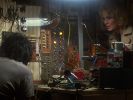Eye For Film >> Movies >> Dressed To Kill (1980) Film Review
Dressed To Kill remains a sumptuous and provocative film long after its initial release, welcoming viewers with its alluring score and softly lit images before teasing and tormenting both its audience and characters alike.
Brian De Palma has perhaps never had more fun than when channelling his love of Hitchcock, through a series of tense, expertly crafted and audacious films. Beginning with Obsession, taking in Carrie, The Fury, Blow Out, Dressed To Kill, and probably ending with Body Double, De Palma was perhaps the most consistent of the ‘New Hollywood’ brood. Not content with taut psychological thrillers, he also found time to make the highly acclaimed Scarface and The Untouchables toward the end of this prolific run.

If De Palma’s star has been very much diminished since the aforementioned heydey - Carlito’s Way aside - then a revisit to Dressed To Kill serves as a delightful reminder of his once prodigious abilities.
Michael Caine stars as Doctor Elliott, a psychiatrist whose patient Kate Miller (Angie Dickinson) - disillusioned with her marital life - is violently murdered after picking up a stranger in an art gallery. Caine and Dickinson bring a certain weight to the film, which De Palma gleefully exploits in his manipulation of audience expectations.
Beginning with a dream sequence in which Kate has visions of being raped in the shower, while her husband shaves with a shiny looking open razor, De Palma pulls no punches in his representation of sex and violence, which are, as the film makes explicit, often inextricably intertwined.
That the shower sequence, the elevator slashing and the disposal of the leading lady early in the picture brings to mind Hitchcock’s Psycho has been well noted. The scenes in which Kate picks up a stranger in an art gallery are fairly obviously inspired by Vertigo and Kim Novak’s gallery wanderings. There’s also more than a hint of Marnie in the film’s storm-laden ending, in which revelations of psychological trauma abound.
De Palma takes the work of Hitchcock, and others - let’s not forget that Dario Argento’s early work is said to be an influence too - and makes it into something all of his own. The gallery sequence, for example, is every bit as tense - and dialogue free - as Jimmy Stewart following Kim Novak around in Vertigo. Yet there’s a role reversal at play here, and a more manipulative game of cat and mouse in which there are more twists, turns, contradictions, false promises and blind alleys than a political manifesto.
De Palma’s masterly control of the scene and everything in it is also apparent through the way in which he repeatedly manipulates focus in the shot, encouraging our eyes to track multiple points of action rather than just focus on one. When Dr Elliott is questioned by the police over the death of Kate, her son Peter (Keith Gordon) sits outside the detective’s office and rigs a microphone to the wall so he can hear the conversation. Not only do we get the audio from inside the room, but De Palma cleverly manipulates the image so we see Caine and Detective Marino (Dennis Franz) discussing the murder and see Peter’s reaction all in sharp focus.
This dizzying abundance of perspectives continues as Peter attempts to solve the mystery of his mother’s death without the help of the police. Also on the case is the only witness to the murder, Liz Blake (Nancy Allen), who is trying to save her own neck by discovering evidence to clear her name.
Another bravura sequence in which Liz is followed by the blonde assailant she believes murdered Kate and a gang of thugs on a subway train, again displays De Palma’s love for ‘pure’ cinema. Indeed, throughout the film there is little dialogue - although much of the best of it is saved for Marino’s gutter-cop slang, which Franz delivers with great New Yorker relish - as the film relies on the power of the image to move the narrative along.
Much of the credit for the film’s success must also be accredited to cinematographer Ralf Bode and editor Jerry Greenberg who undoubtedly deliver on bringing De Palma’s vision viscerally to life on screen. Michael Caine also deserves recognition for the control of his performance, as the simplicity of his portrayal of a tortured psychopath not only serves to ramp up the tension but also helps to give the impression of credibility, which is always at risk of being churned up in the wild machinations of the plot.
Reviewed on: 27 Jul 2013

















